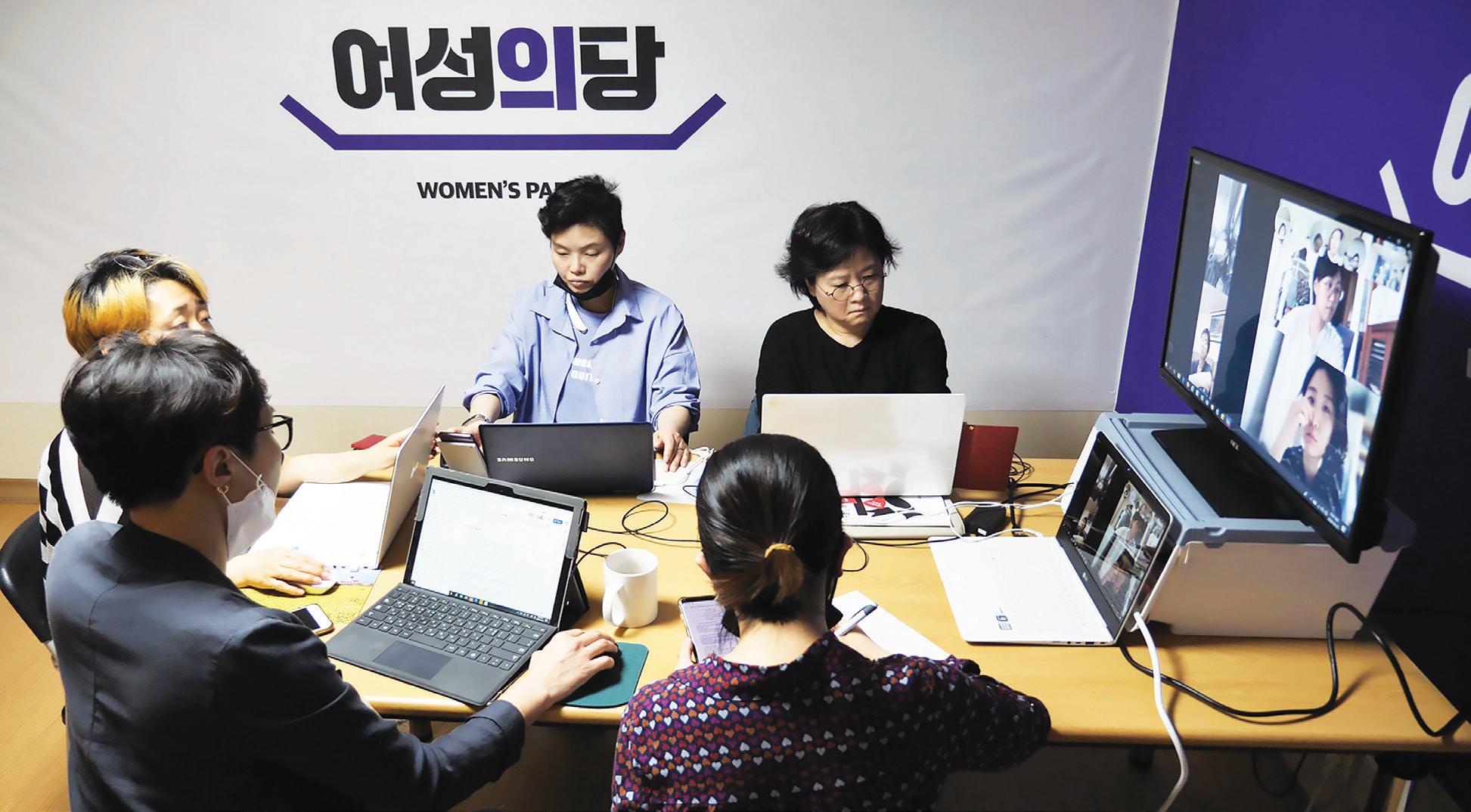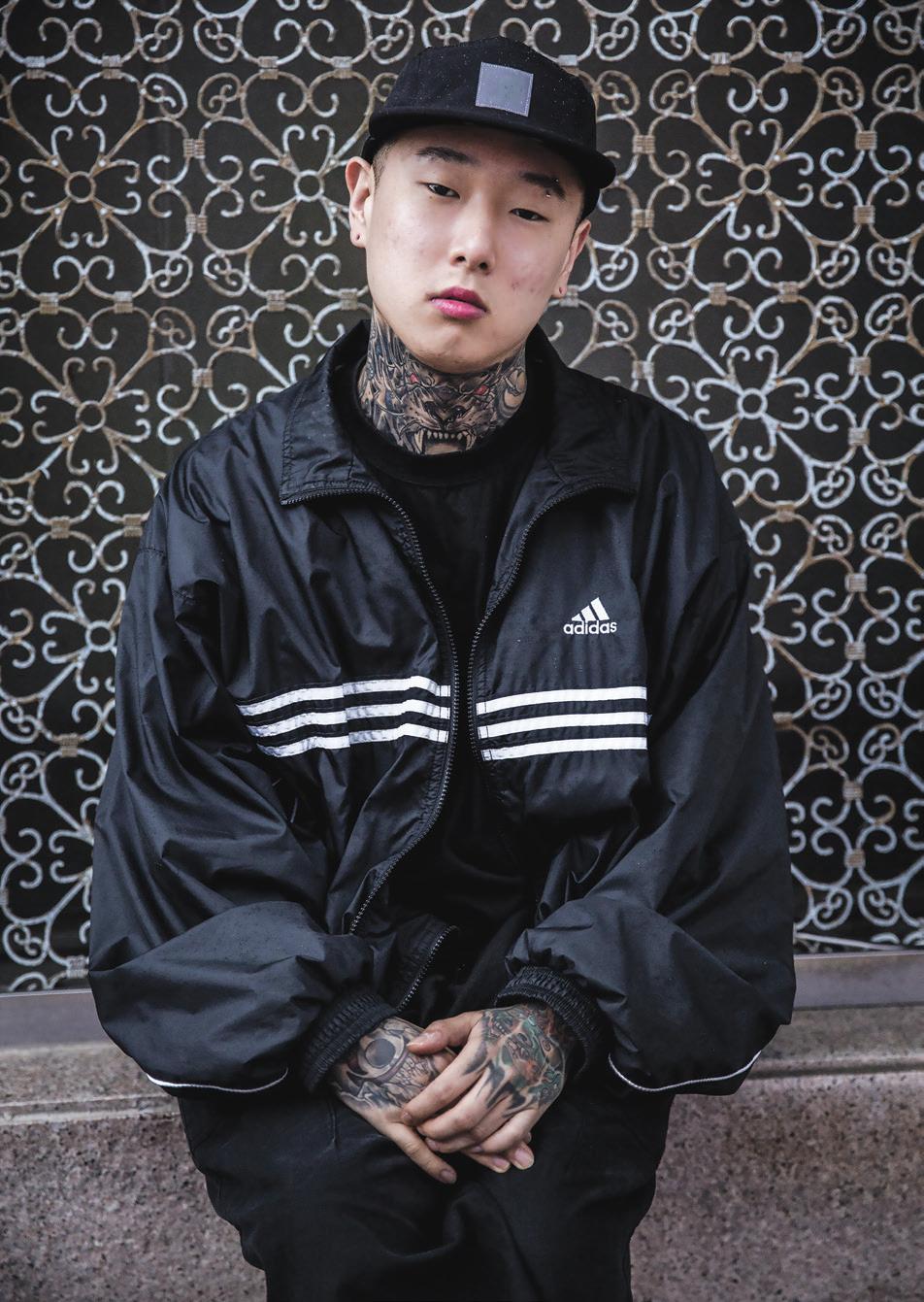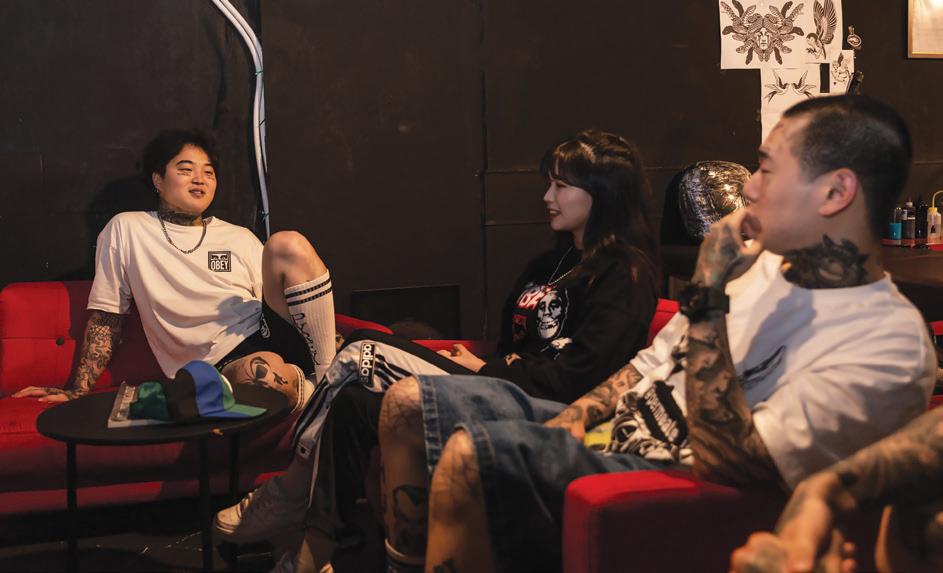
14 minute read
Th e 2020 Michael Simning Community Builder


Advertisement

Recognizing Contributions to the Gwangju Community: Th e 2020 Michael Simning Community Builder Award
Every year, the Michael Simning Community Builder Award (MSCBA) is given to recognize members of society who contribute their time and eff ort to make Gwangju better. Th e award is named aft er the late Michael Simning who was not just a Gwangju expat but also a dedicated community leader, caring friend, husband, and father. Each year for the past six years, to honor Michael’s memory and legacy, Gwangju nominates new community builders, activists, and networkers for the award. Th is year’s nominees were Dr. Shin Gyonggu, Sandy V. Loreno (this year’s runner-up), Darrell Slater, and Andrew Vlasblom.
On Saturday, June 6, it was announced at Th e First Alleyway that Dr. Shin Gyonggu was the recipient of the 2020 MSCBA. Dr. Shin is the director of the Gwangju International Center (GIC) and a former professor at Chonnam National University. He has been working to help build the GIC from its inception 21 years ago as a service to the community. Dr. Shin is a role model when it comes to community engagement, social responsibility, and charity work. Th e GIC he has helped sustain is a hub that merges Gwangju’s international and local communities into one. It off ers a wide variety of services that include legal consulting, translations, language exchanges, the GIC Talk, cultural classes, and so much more. Here are some of Dr. Shin’s thoughts about Michael Simning that he shared in accepting the community builder award:
“Michael once said, ‘I came to Gwangju with only a backpack, but I formed a great family here with a beautiful wife and a pretty daughter.’ In this regard, I’m similar to Michael. I also came to Gwangju in the same way. I had nothing but a military backpack. I didn’t know anybody in Gwangju. But I also met a lady and formed a family with one son.
“However, I’m also quite diff erent from Michael. He was outgoing and creative. He created many projects including Speakeasy, Th e First Alleyway, the Underground Grocers, and the Gwangju Blog, among many other things. Michael was a born networker.
“In contrast, I was born as an introverted person. I feel comfortable when staying at home all alone. I cannot drink, so I don’t ‘speak easy.’ I also don’t mingle with other people comfortably. But I was obliged to be the director of the Gwangju International Center. I found it was a house built on sand. But I continued to work with it, and although I was and still am an extreme introvert, I’m also not one to quit easily. I feel humbled when I’m recognized like this. I want to thank the committee for choosing me for this prize, which I think I do not deserve to receive.” Although Dr. Shin thinks he does not deserve this award, everyone connected to the Gwangju International Center is immensely proud of him! In addition to a crystal plaque, Dr. Shin was awarded a check for 300,000 won to be donated to a charity or program of his choice.
Michael Simning (1974–2014) came to Korea in 1995 from Canada. In addition to teaching, Michael created Speakeasy, a place where expats could socialize; was cofounder of the Underground Grocers, where the foreign community went for hard-to-fi nd foods and cooking ingredients; co-founded Th e First Alleyway, which still off ers the best Canadian-style meals in Gwangju; and was an announcer at GFN, Gwangju’s only foreign language radio station. Michael somehow also found time to serve the community in a myriad of additional ways, oft en collaborating with the GIC and its director, Dr. Shin. Michael left us much too soon – in early 2014, aft er a long bout with leukemia.
Th e Michael Simning Community Builder Award Committee has been selecting award winners since 2015. Previous award winners were Al Barnum (2015), Jeff Hamilton and Kelly Palmer Kim (2016), Sarah Elizabeth Hale (2017), Dana Han (2018), and Daniel Wallace (2019). Th e committee currently consists of fi ve members: Tim Whitman (Th e First Alleyway, Chosun University), Chris Bleeker (SIS international school), Bill Mulligan (Kwangju Women’s University), David Shaff er (Gwangju News, GIC), and Arlo Matisz (GFN, Chosun University). Each spring, the committee puts out a call for nominees for the MSCBA on their Facebook page, Gwangju Community Builders. Th e award winner is announced in the beginning of June to coincide with Michael’s birthday.
Coretta King once said, “Th e greatness of a community is most accurately measured by the compassionate actions of its members.” Gwangju is a big, diverse family with a fl amboyantly vibrant soul that never tires. So, let us be like our nominees and our winner – restless, creative, and compassionate. Let us make our community even better by lift ing up and helping one another just as Michael Simning did.
A Gwangju News article on Michael’s life can be found at https:// gwangjunewsgic.com/features/16657/
The author
Cami Ismanova is a student at Chonnam National University majoring at economics. She loves to travel, listen to jazz, and read books. She is into drawing still lifes, growing plants, and writing these days. Instagram: @camidisman
Korea’s Women’s Party
Written by Cristina Murano
Tipping Point
On International Women’s Day (March 8), members of South Korea’s Women’s Party gathered at Seoul Arts College to celebrate the party’s inauguration. This formation embodies a tipping point in South Korean socio-politics, with tipping point being defined as “the critical point in a situation, process, or system beyond which a significant and often unstoppable effect or change takes place.” This tipping point is a culmination of decades of sexism and violence against women that needs to be addressed with greater public urgency.
In 2015, Statistics Korea and the Ministry of Gender Equality and Family determined that South Korean men “spent an average of 45 minutes a day on household chores [while] women spent 227 minutes on household chores – five times longer than men.” [1]
Spycam cases “jumped to nearly 6,500 in 2017 from about 2,400 in 2012.” [2] In fact, more than 6,000 cases “are reported to the police each year and 80 percent of the victims are women.” [3] Note that this number accounts for only the cases that are reported.

A survey carried out by the Seoul Foundation of Women and Family on discrimination among youth found that “female youth experience greater discrimination by over 10 percentage points than their male counterparts in three categories: gender, age, and academic achievement.” [4]
Earlier this year, the Organization for Economic Cooperation and Development published data about the gender wage gap in its member countries. South Korea had the largest wage gap at 34.1 percent, meaning men on average make 34.1 percent more than women. This is the 17th consecutive year that South Korea has topped this list. [5]
Interview
In an interview with the Women’s Party co-president, Kim Jina, I asked her to describe the party’s goals and challenges. Gwangju News (GN): What are your short-term goals? Kim Jina: Our short-term goal is to have parliamentary members in every city and province after the 2022 local elections. To achieve this, we will form twelve city and provincial consistency branches in addition to the present five nationwide city and provincial branches and create local organizations. Through the Digital Sexual Crimes Agenda Organization, we are currently proposing and passing legislative measures related to the 21st general elections. In addition, to change a maledominated political climate, we need to develop a model for female empowerment and leadership. The Women’s Party is currently designing “political schools” and “parliamentary schools” to meet these ends.
GN: What are your long-term goals for the party? Kim Jina: Economically speaking, South Korea is a developed nation, but its parties and the National Assembly are still quite male-controlled. The Women’s Party was formed to make policies and laws that advance the agenda of women’s rights, which have been repeatedly neglected by the major political parties amid their power struggle. In addition, cultivating young women as political leaders is not only a long-term goal but an urgent task at present. How else can we have a presidential candidate for the next term?
GN: What are some of the major challenges you face as a party? Kim Jina: The Women’s Party held a promotional meeting last February 15, an inauguration ceremony on March 8, and ran during the general elections on April 15. Is this not a record worth entering into the Guinness Book as “fastest party formed”? Since the general elections, the party’s efforts have been focused on drafting the party constitution and the party regulations in order to strengthen its foundations. After collecting the opinions of all the party members and holding a series of intense debates, we are close to the final stage. Seventy-seven percent of the Women’s Party are in their teens and twenties. The level of passion is as intense as in any other party, but the pressing challenges that party

members face as they strive for education, employment, and survival in a sexist system are urgent. Th e fi nancial diffi culties are that much more pronounced. Th e party can only sustain itself with the interest and support of the older generation that believe in the party’s value and potential. We are considering how to build a sustainable structure to see positive outcomes and run for elections.
Public Governance
Proportional representation in South Korea’s electoral system is intended to create an easier pathway for candidates from emerging parties to get elected. However, this hinges on a number of factors, such as regional politics, competition, campaign funding, and public attitudes.
While the Women’s Party did not have any representatives win seats in South Korea’s 2020 national elections, a record number of “209 female candidates ran in constituencies. With proportional representation seats included, there are 57 women elected, representing about 19 percent.” [6] Change is happening in South Korea, but the formation of the Women’s Party signals that this change is happening far too slowly.
Having women elected to the legislature who represent the needs of women and advocate for gender equity is necessary for a strong and thriving South Korean democracy. It increases accountability, social inclusion, diverse funding initiatives, and balance between groups, ultimately benefi ting a broad range of people rather than a select few. Th e Women’s Party embodies a growing feminist movement in South Korea that aims to elevate women’s leadership and strengthen women’s rights in public governance. Th is tipping point has been long overdue.
References
[1] Ock, H. (2015, December 7). Korean men do least housework in OECD. Th e Korea Herald. http://www.koreaherald.com/view. [2] php?ud=20151207000891 Reuters. (2018, October 22). “Spycam” epidemic seizes South Korea’s women. Al-Jazeera. https://www.aljazeera.com/news/2018/10/ epidemic-seizes-south-korea-women-181022042455511.html [3] Bicker, L. (2018, August 3). South Korea’s spy cam porn epidemic. [4] BBC News. https://www.bbc.com/news/world-asia-45040968 Kim, B. (2020, May 4). Female and male youth report stark diff erence in appearance-related stress. Th e Korea Herald. http:// www.koreaherald.com/view.php?ud=20200504000556 [5] Kim Yon-se. (2020, May 12). Korea unrivaled in gender wage gap among OECD members: Korean women make nearly 35 percent less than men. Th e Korea Herald. http://www.koreaherald.com/view. php?ud=20200512000189 [6] Ock Hyun-ju. (2020, April 16). Regionalism, two-party dominance back to politics in S. Korea: A record number of women took constituency seats. Th e Korea Herald. http://www.koreaherald.com/ view.php?ud=20200416000918
Resources
— For further reading, see Min Gyeong Lee’s works: Reclaim the Language (2016), Reclaim the Wage (2017), and Escape the Corset: Th e Arrival of an Imagination (2019). — For more information or to get involved, visit the Women’s Party website at www.womensparty.kr and follow on Twitter @ womensparty2020 or Instagram @womensparty2020.
The author
Cristina Murano’s work is in the areas of education, equity, public governance, and sport, with a focus on youth, women, and 2SLGBTQ+ people. She is originally from Toronto, Canada. Instagram: @profondoluce
Tattoos: “WHY NOT”?

Written and photographed by Yunkyoung Hillel Kim
What is your first thought when seeing someone covered with tattoos? Cool, or not? As I look back on my previous photography, there are many people with tattoos. I could definitely say that the “tattoo” is one of my key themes. However, I typically have not taken pictures of the transition of one particular person as he or she collects more tattoos as time goes by. This article will show you the journey of one person named Hun not only as he adds more tattoos but also the photographic transition that took place in the process. I hope this article gives you a chance to expand your thoughts on tattoos and photography.
It was a year ago, with my camera, when I was wandering around Chungjang-ro to find someone dope to shoot. I stopped by a shop and a staff member came to me and ask about my camera. She was the first person who ever came up to me, asked questions, and showed interest in my camera. I told her that I could answer her questions if she would allow me to take some pictures of her, and she gladly posed for me. Then she pointed out her senior staff member who soon would also be interested in standing in front of my camera. That was how I first met Hun. Since then, every 2–3 months I have visited him and taken his picture. Since he and I are both photographers and fashion bloggers, we are a good match.
Aug. 30, 2019: The first day we met.

Sept. 24, 2019: Starting work on a new neck tattoo. ▲


Oct. 10, 2019: Th e fourth time in his shop. ▲

Aft er I took his picture on the 14th of May, I thought he was complete as an artist. He is now confi dent and fully focused compared to 10 months ago when we fi rst met. I asked him if I could meet his tattoo artist and, one week later, Hun and I visited “1lusion_Ink.” I had about an hour-long interview with “Illusion,” and I learned the real behind-the-scenes story of the tattoo industry in Gwangju.
According to tattoo artist “Illusion,” it has been about 15 years since the tattoo industry started in Gwangju, which began with “Red Ocean,” continued with “Illusion,” and is now on its “third generation” of artists. Today, there are more than 100 tattoo shops in Gwangju.
Most of the time, Illusion was critical about the reality of the tattoo industry in Gwangju. People are saying that Gwangju is a city of art, but he somewhat disagrees with that claim due to a lack of understanding among the public. For example, as he and Hun walk through suburban areas of the city, without exception, they are criticized by elders. Th is is why young people who want to pursue further and deeper artistic tracks leave for Seoul, where about a thousand tattoo shops are located in the Hongik University area alone. As an outcast not only in society but also in the tattoo scene in Gwangju, it must be tough, but Illusion strongly expressed his will to stay in Gwangju to spread his artwork.
May.14, 2020: More face tattoos. ▲


Hun is Illusion’s best friend and walking shop advertisement. He has been working on Hun for fi ve years for free and plans to keep on doing so. At one point in our conversation, I asked Illusion what it means to get a face tattoo, since he himself and Hun each have several on their faces. Both of them gave the same answer: “Why not?”
In their answer, I found the core message for this article. Even I, who loves taking pictures of people with tattoos, have limits and prejudices regarding face tattoos. However, despite my views, I know there is no limit to art.

The Author
Yunkyoung (Hillel) Kim is a priest in the Anglican Church and also a portrait photographer. More of his pictures can be found on Instagram: @hillelkim










